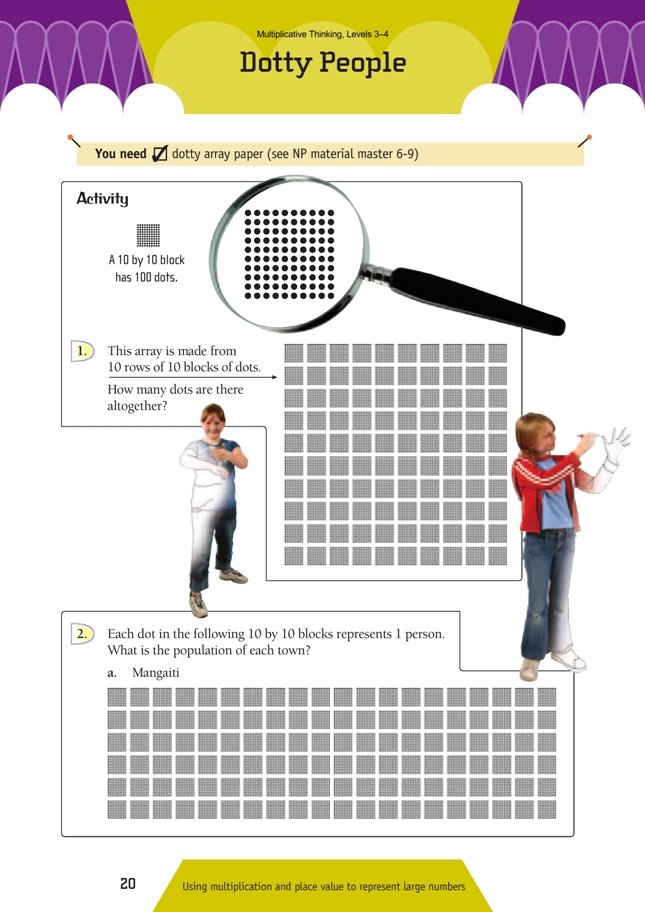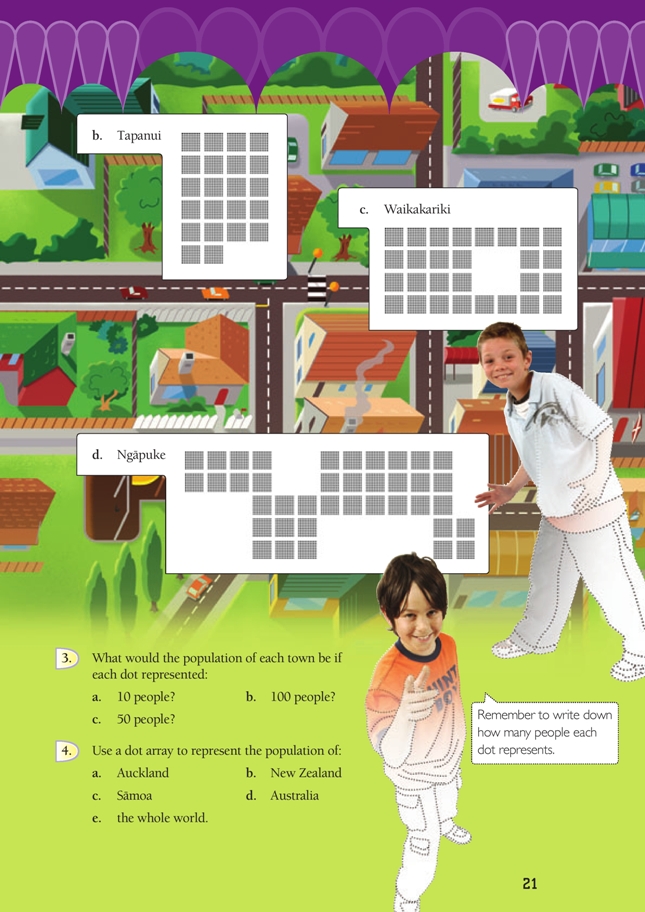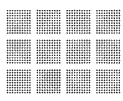This is a level 3 number activity from the Figure It Out series. It relates to Stage 6 of the Number Framework.
A PDF of the student activity is included.
Click on the image to enlarge it. Click again to close. Download PDF (1633 KB)
use place value understandings and multplication to solve problems involving large numbers
Number Framework Links
Use this activity to encourage transition from advanced additive strategies (stage 6) to advanced multiplicative strategies (stage 7).
Dotty Array Paper (Material Master 6-9)
This activity explores multiplicative place value, a concept essential to students’ understanding of large whole numbers and their ability to perform multiplicative calculations. The activity is based around the use of a 10 by 10 dot array. Students know that this array contains 100 dots, so it provides a good starting point for further exploration.
It is essential that, when calculating with large whole numbers and decimals, students pay attention to unit size. Rules that they may have learned, such as “add a zero” to multiply by 10, work with the simple examples that they first encounter but lead to serious misconceptions when working with numbers that have a decimal point, for example, the misconception that 2.4 x 10 = 2.40. When multiplying by 10, the students must make the connection between a basic fact and the units being multiplied. For example, we can represent 40 x 30 = with dots, as follows:
The display shows that 4 x 3 = 12 is embedded in the array. The 12 units are each one hundred
(10 x 10). Extending that idea gives results such as:
300 x 40 = 12 000 because the units are 100 x 10 = 1 000 (one hundred tens is 1 000)
0.3 x 400 = 120 because the units are 0.1 x 100 = 10 (one-tenth of 100 is 10)
0.3 x 0.4 = 0.12 because the units are 0.1 x 0.1 = 0.01 (one-tenth of one-tenth is one-hundredth).
Solving problems of this type requires a number of key understandings:
• Multiplication means “of”. Just as 7 x 4 means 7 sets of 4, 1/2 x 1/4 means one-half of one-half and 1/4 x 20 means one-quarter of 20.
• Multiplication does not always result in an answer that is bigger than either of the original two numbers. Students generalise incorrectly from whole-number examples such as 3 x 5 = 15 that “multiplication makes bigger”. Contradictions emerge when they encounter examples such as 1/3 x 6 = 2 or 1/2 x 1/2 = 1/4.
• The base 10 place values involve a pattern of multiplying by 10 (a movement to the left), for example, 10 x 100 is 1 000, and dividing by 10 (a movement to the right), for example, 1 divided by 10 is one-tenth. In this case, the division means dividing into 10 equal parts, for example, one-hundredth divided into 10 equal parts gives one-thousandths.
• Equivalent fractions are essential to understanding the place value units involved in decimal multiplications. For example, one-tenth of one-tenth equals one-hundredth
(0.1 x 0.1 = 0.01); this is derived from the fact that is equivalent to 10 hundredths.
While they are working through the problems in Dotty People, ask the students to find the sides of the rectangles for which they are finding the number of dots. Discuss with them the links between these side lengths, the basic multiplication fact that can be employed, and the units involved. For example, the population of Mangaiti is represented by a 200 by 60 rectangle. The basic fact is 2 x 6 = 12, and the units are tens of hundreds, or thousands. So the answer to 200 x 60 is 12 000.
Questions 2b, 2c, and 2d involve compound shapes for which students will need to add or subtract the number of dots in different rectangles. For example, to find the population of Waikakariki, they might find the number of dots in a complete 80 by 40 rectangle (3 200) and subtract the dots that would be in the missing rectangle (20 x 20 = 400).
Questions 3 and 4 are about the effect of changing the scale factor and the use of scale factors that are appropriate to a situation. The effect of making each dot equal to 10 is equivalent to the operation “multiply by 10”.
For example:
1 dot represents 1 person (40 by 50 array) 2 000 people
1 dot represents 10 people (40 by 50 array) 20 000 people
1 dot represents 100 people (40 by 50 array) 200 000 people
In answering question 4, students need to consider the implications of their choice of scale. If the numbers are very large, a suitable scale must be selected if the display is to be practical. For example, the population of the Earth is about 6.5 billion people.
If each dot represents 10 people, 600 000 000 dots are needed; that’s an array of 30 000 x 20 000 dots, which is obviously not practical.
If each dot represents 1 000 people, 6 000 000 dots are needed; that’s an array of 3 000 x 2 000 dots.
If each dot represents 1 000 000 people, 6 000 dots are needed; that’s an array of 300 x 20 or 150 x 40 or 75 x 80. That display works!
Answers to Activity
1. 10 000 (ten thousand). (10 x 10 = 100 blocks; 1 block has 100 dots, so 100 x 100 = 10 000 dots.)
2. a. Mangaiti 12 000 (twelve thousand)
b. Tapanui 2 200 (two thousand, two hundred)
c. Waikakariki 2 800 (two thousand, eight hundred)
d. Ngapuke 3 900 (three thousand, nine hundred)
3. a. (Multiply each population by 10.)
Mangaiti 120 000
Tapanui 22 000
Waikakariki 28 000
Ngapuke 39 000
b. (Multiply each population by 100.)
Mangaiti 1 200 000
Tapanui 220 000
Waikakariki 280 000
Ngapuke 390 000
c. (Halve the answers to b.)
Mangaiti 600 000
Tapanui 110 000
Waikakariki 140 000
Ngapuke 195 000
4. a.–e. Dot arrays will vary, depending on the population figures used and how many people each dot represents. Approximate populations (2006 figures in brackets) are: Auckland: about 1.3 million (1 337 000) New Zealand: about 4 million (4 130 000) Samoa: about 170 thousand (177 000) Australia: about 20 million (20 264 000) World: about 6.5 billion (6 525 170 000).


